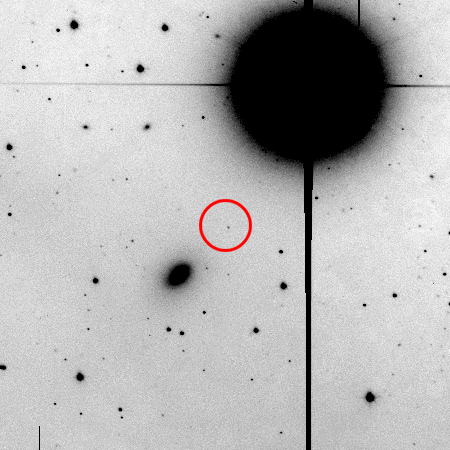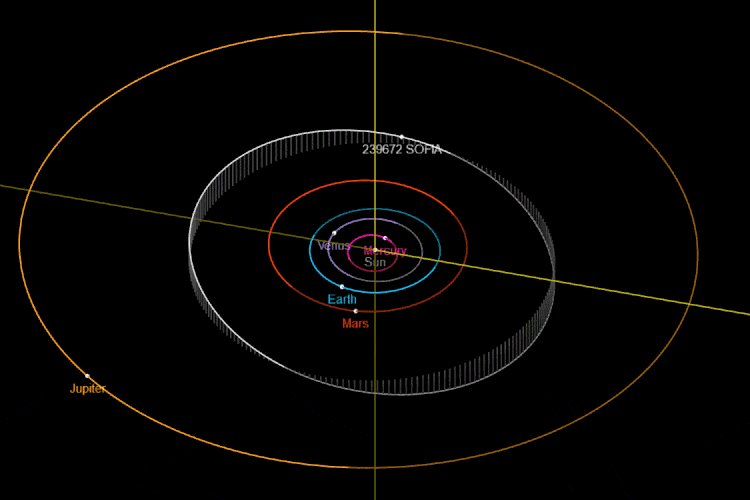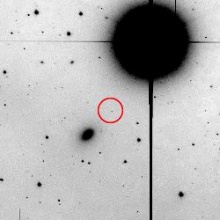SOFIA, the Stratospheric Observatory for Infrared Astronomy, has received a very special honor: As of April 30 th, 2018, the asteroid number 239672 bears the name of the flying observatory – as announced by the Minor Planet Center (MPC) of the International Astronomical Union (IAU).
-

Animation aus zwei zeitversetzten Aufnahmen von
2008 YS 1 = (239672) SOFIA aus der Entdeckungsnacht am
1.23 m Calar Alto Teleskop (Belichtungszeit 180 s,
Johnson R-Band Filter; Epoche der Aufnahmen:
22.12.2008 00:09 / 00:31 UTC). Die gemessene scheinbare
Helligkeit des Asteroiden beträgt R=19.8 mag
(Copyright: Felix Hormuth).
The designation came from the initiative of Felix Hormuth, who discovered the asteroid during the night of December 21 st, 2008 using the 1.23 m telescope at the Calar Alto Observatory. A time series of exposures revealed the object’s continuously changing position. Once the discovery had been confirmed, the MPC labeled the minor planet with the temporary designation "2008 YS 1".
After numerous other observers had traced the position of the newly discovered minor planet over time, it received a permanent ID number. To assign a number, the MPC requires reported observations that span at least four opposition periods. During an opposition period, Earth laps the asteroid on its orbit around the Sun, allowing observations over a large fraction of the night. After accumulating observations over at least four of such orbital laps, the asteroid’s orbit can be calculated with sufficient precision to recover it in the future.
Once numbered, the discoverer has the privilege to propose a name within ten years, following various criteria. An international IAU committee of fifteen astronomers will then decide whether to accept the proposal or not. Back in October 2017, Felix Hormuth visited the Calar Alto Observatory once again, and met with Karsten Schindler of University of Stuttgart’s DSI (Deutsches SOFIA Institut) to observe a stellar occultation by Neptune’s moon Triton, simultaneously with SOFIA. That triggered the idea: "As SOFIA explores our solar system in a unique way, I feel it is well deserved to dedicate a namesake to this flying observatory, one that is a permanent outpost outside of Earth’s atmosphere.", said Felix Hormuth.
-

Die Bahnkonstellation des Asteroiden (239672) SOFIA, dargestellt im
Zeitraum vom 06.06.2018 bis 05.06.2019.
(Copyright: JPL Small Body Database Browser
(239672) SOFIA orbits the Sun in the outer Main Asteroid Belt of our solar system between Mars and Jupiter – a SOFIA year equals 4.81 terrestrial years. The exact size of the asteroid has not been measured yet. Assuming a spherical body with average reflectance, its diameter would be somewhere between 4.6 km (C-type asteroid with a darker, carbonaceous surface) and 1.8 km (S-type asteroid with a brighter, stone-like surface), depending on its geological and chemical composition. It is most likely, however, that (239672) SOFIA is rather an irregularly shaped body.
Due to the current position of the Earth relative to (239672) SOFIA, another observation of the minor planet will not be possible before fall of this year, when (239672) SOFIA will be visible again in the morning sky. Until then, the minor planet orbits behind the Sun as seen from Earth.
Weitere SOFIA Links
| Contact | Dörte Mehlert, Email: mehlert@dsi.uni-stuttgart.de; Tel.:0711 - 685-69632 |
|---|



